Neshan 43

Reference-II
Mimmo Castellano; The Territories Of The Project
Cinzia Ferrara
Talking of inter-disciplinary design reminds us of the discipline of design, which has long been open to collaboration with other fields of study and professional competences, encouraged by its strong, inborn “dialoguing, relational” spirit.
Having developed an identity and a structure whose boundaries are blurred and always open to change, interdisciplinary design occupies a specific place within the larger discipline. Long before the notion of inter-disciplinary work became a talking-point, it was hinted at through the notion of a designers progression from education through professional life. A key figure in identifying this approach, was Gillo Dorfles, an Italian artist, critic, and philosopher, who attempted to demonstrate the connections between various disciplines and industries as opposed to the issues that divided them. One of the pioneers of an interdisciplinary design process,even when it was not acknowledged as such by the professional community.
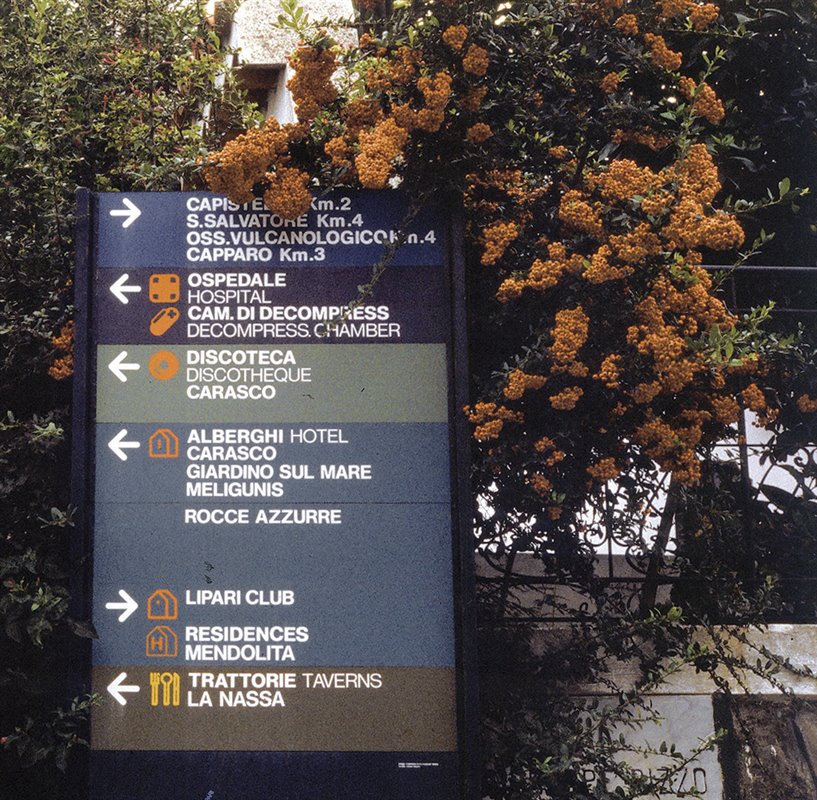 Isole Eolie, Signage, 1975
Isole Eolie, Signage, 1975
 Isole Eolie, Logo and Signage, 1975
Isole Eolie, Logo and Signage, 1975
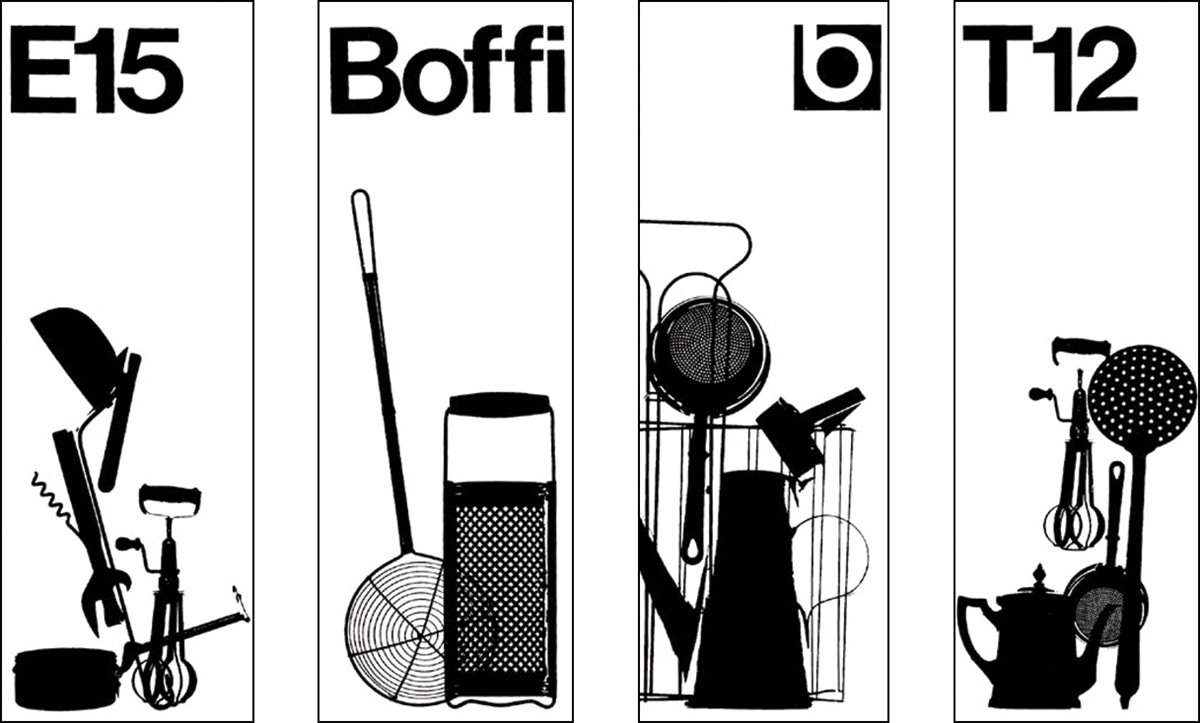 Boffi Corporate identity, Boffi furniture kitchen, Wings for stands, 1970-72
Boffi Corporate identity, Boffi furniture kitchen, Wings for stands, 1970-72
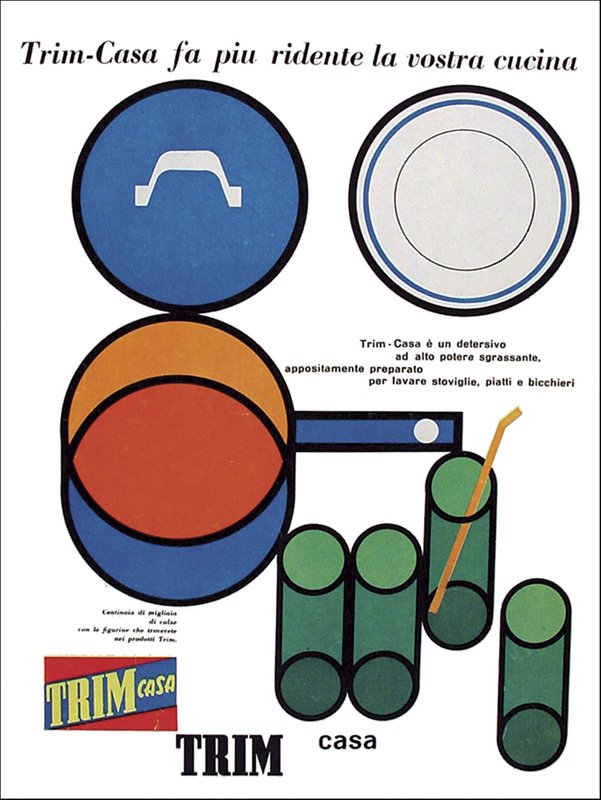 Trim Casa, Advertising for a house detergent, 1958
Trim Casa, Advertising for a house detergent, 1958
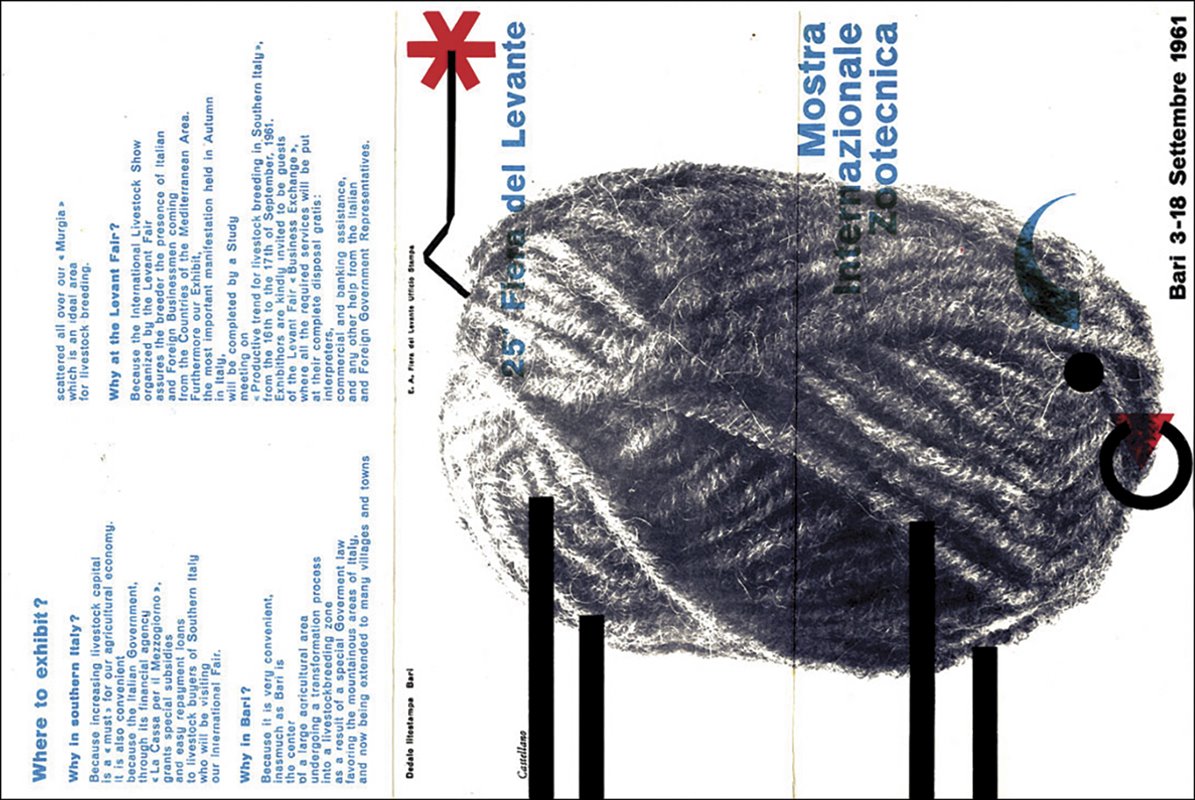 Fiera del Levante, Bari, Folders, 1960
Fiera del Levante, Bari, Folders, 1960
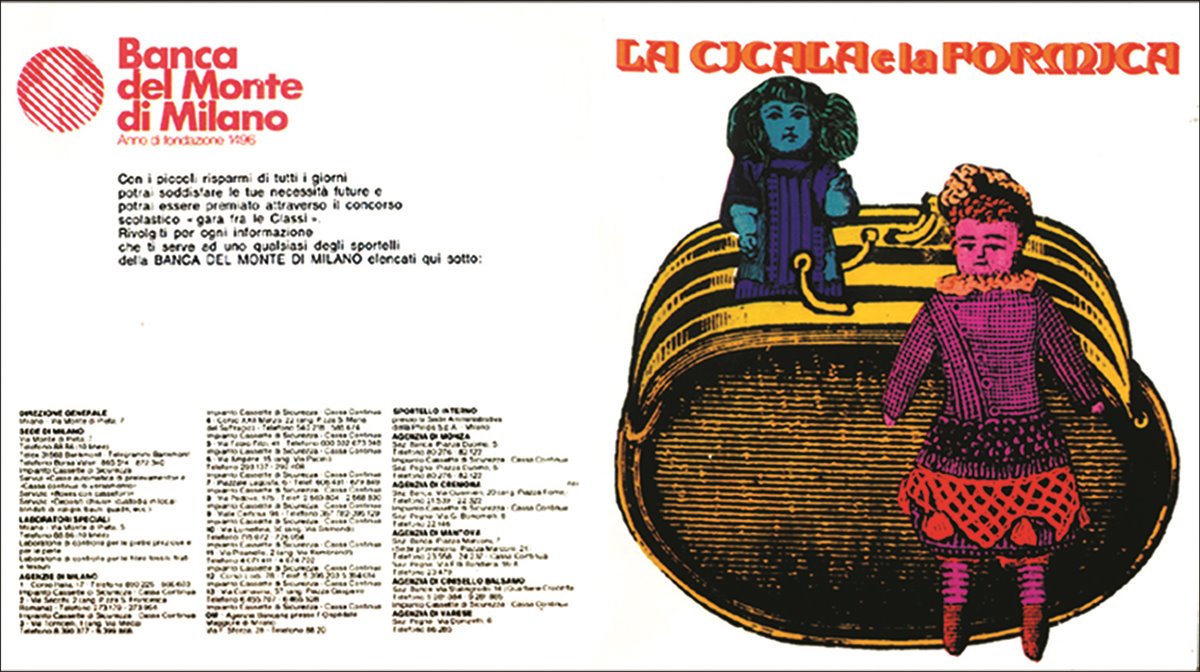 Banca del Monte di Milano, Folder, 1970
Banca del Monte di Milano, Folder, 1970
Talking about Mimmo Castellano is not easy: he is a crucial figure in the history of national and international graphic design, but at the same time he is not adequately known and studied. Perhaps also because he was—at least at the beginning of his career—he did not get a large amount of exposure due to both geographical location (he started working in Apulia and moved to Milan in 1967, where he would remain, until his death in 2015), and also to having a shy, contentious disposition. Yet it is precisely these qualities that allowed him, at the beginning of his career, to be thrust into the limelight as a pioneer in his profession. Castellano worked with the big industry and business, and managed to deftly weave those relationships together with cultured, enlightened clients to produce the best results in the field of design. Through this spirit, he introduced modern graphics, to these—often difficult to navigate—territories. .
His projects are displayed on history of graphics books, and one may easily tend to only praise him, which is as obvious an attitude as it is by all means one to be avoided. For this reason, I will try to look at his projects through the special lens of words, those significant and recurring words which, together, are able to build a map to guide us in learning more about his work.
The term multiple describes not only Mimo Castellano’s training, which is neither canonical nor linear, but stimulated through branching out into graphics and photography. Castellano developed his skills by building on his natural talent for manipulating shapes, colours, and dimensional relationships in both two-I and three-dimensional space. In his work there seems to be a constant transmigration from one dimension to another, with the graphic shapes flirting with dimensionality and the photographed volumetric objects shrinking into thin, two-dimensional silhouettes. The graphic designer Castellano feeds the photographer Castellano and vice versa, in a tight-knit relationship, suspended between bold aspirations for the future and a poignant look to the past. This work is further characterized by continuous experimentation and a phenomenological and anthropological research into both historical and contemporary culture.
Like two peaceful kings jousting for power, his graphic design and photography work never cease their dialogue and manage to maintain their absolute autonomy.,
Alongside graphics and photography, architecture also becomes a point of exploration for Castellano, who found himself designing a number of pavilions, stands and exhibitions. Many commissioned by for by major national companies such as RAI Radio Televisione Italiana, Alitalia, Italsider and Montecatini, among others. These projects complete a set of professional skills that make him an unusually complex and multifaceted figure—a multi- and inter-disciplinary figure. Further evidence of this is his 1954 collaboration with, director Anton Giulio Bragaglia and with Art director Paola Borboni as the stage designer of Compagnia Stabile di Prosa of the city of Bari.
Surprisingly, his beginnings were in editorial graphics and book design— dealing with that small, well-defined object that became his main focus for almost 25 years.During that time, which he designed the visual identity of the Bari-based publisher Laterza, and his relationship with editorial graphics continued to grow,marked by important collaborations with Carlo Ludovico Ragghianti, Umberto Eco, Leonardo Sinisgalli.
In addition to the terms multiple, graphics and photography, we must also consider the term territory as a way to describe Castellano’s work. Or, better, territories, as many were the territories in which he lived that helped define his work. In many ways,Southern Italy where he grew up, and which he described as a ‘rough and generous land’, set a baseline for his character as he would develop.
The many territories in which he lived and worked throughout his life informed much of his design. Many of his works that deal with situations at the territorial scale – displaying a certain complexity in terms of geographical extension and cultural density –fall into this area. Among the most notable of these are the Tourist Signs for the Aeolian Islands. Although their ultimate fate was not a happy one, their importance is nevertheless highly relevant still to this day. Indeed, the project is often used as a case study in the preliminary analysis of many similar projects. Created in 1976, it appears as an interesting experiment in the systematization of information, based on the adoption of a simple language, —understandable by everyone regardless of language—and the use of a large number of pictograms- diagram-like signs, and the adoption of unitary modules for the design of terrestrial and nautical maps.
This project leads us to another term that synthesis. This word, as it is used in Kant’s philosophy, acquires the meaning of the simplification of what is complex, reaching a singular conclusion drawn from a variety of elements. The ability to synthesize transcends all of Castellano’s work as a photographer, and as a graphic designer. The absence not only of the superfluous and the redundant, the obvious and the easy-to-guess, makes his work an example of the search for moderation and balance. His work represents a synthesis that is never merely reduction, but is accompanied by a continuous, tireless experimentation. This experimentation would sometimes take him off-track, motivated by the desire to learn the use of new instruments, (computer-based modelling techniques that have given life to a herd of odd, bizarre characters, children of a tireless imagination but also outside its control – as if it had granted these artificial creatures the power of self-generation, children of those machines that, just like them, have nothing human. Experimentation in computer-based design, graphics and photography were Castellano’s passion in his later years. For him, this gesture was a strong rebuke to anItalian society that he described as being “on ‘vacation’ from culture, one which does not seem to need advanced professional competences, but rather approximate, improvised routines”.
In addition to these explorations of new worlds, what remains of Mimmo Castellano is a sharp and dry outline, measured and measurable, mechanically reproducible, always contemporary with a hint of the near future. He is a designer who consciously chooses representational tools and production methods, continually experimenting with solutions and language in order to advance the correspondence between form and content—amain tension of design.
Talking about Mimmo Castellano is not easy— he devoted all his life to design, photography, research, and education. He taught at the Academy of Fine Arts of Bari (1970-71), the ISIA of Urbino (1981), the IED of Milan, Turin and Cagliari; he was a member of AGI and an Honorary Member of AIAP. The space of a single article can barely do justice to his accomplishments and the multi- and inter-disciplinary breadth of his work. His work crosses multiple territories leaving in them deep marks, valleys, and gorges which wait to be studied and explored.
Cinzia Ferrara
is researcher professor, Aiap President, architect and graphic designer. Besides her design work, she writes on visual communication, teaches and holds lectures at international conferences and several Italian universities and design schools. She has written numerous essays and articles published in national and international magazines. She is the supervisor as well as organiser of conferences, exhibitions and workshops. She lives and works in Sicily that is a continent more than just an island.
cinzia.ferrara@unipa.it
New Situation For Problem Solving
Mehdi Haghshenas
> more
Opinion
Iconology Within The Domains Of Modern Methodologies And Graphic Design
Nahid Abdi
> more
Iranian Contemporary Design
Masood Sepehr; Graphic Designer, Researcher, Typographer And Teacher
Mostafa Assadollahi
> more
Project-I
Lefts Better Than Rights! ChapChinStudio
Saed Meshki
> more
Project-II
Tough And Firm
Saeid Forootan
> more
Design Today
John Maeda; The Intersection Of Design, Art, And Technology
Amin Nasr
> more
Face To Face-II
Face To Face With Erwan Bouroullec; The Well-Balanced Design
Majid Abbasi
> more
Face To Face-II
Face To Face With Angelika Nollert; Super Contemporary
Jens Mueller
> more
Reference-I
Sculptures To Wear; A Review Of Ornaments Designed By Parviz Tanavoli
Ali Bakhtiari
> more
Different
City, Graffiti And Individuality; “You Are Here” A Project By Monir Zarnegar
Alireza Taghaboni
> more
Overview
Transformation Design; Designers As Superheroes
Foad Farahani
> more